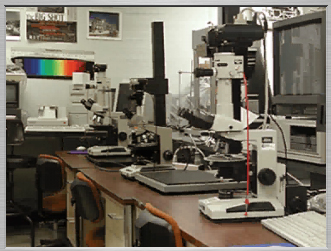
High magnification laboratory, BPC, RIT
The Biomedical Photographic Communications (BPC)
program
at the Rochester Institute of Technology
by Michael Peres
Professor,
Biomedical
Photographic Communications, RIT
(Micscape Editor's note: An introduction to the articles
written by students on
RIT's 'Principles and applications of photomacrography' course
November 2004,
November 2006 and November 2007.
Please click following links to view these articles. November 2004
, November 2006 , November
2007.)

High magnification laboratory, BPC, RIT
The Biomedical Photographic Communications (BPC) program at the Rochester Institute of Technology has the only program in the nation that grants a Bachelor of Science degree in this exciting area of visual communications that prepares students for photographic and imaging careers found in various science related institutions including: forensic labs, pharmaceutical companies, health care and medical research centers, ophthalmic practices, law enforcement and military organizations. Additionally, because of curriculum flexibility, recent graduates have been successful finding positions in the electronic imaging field as technical service representatives or producers of multimedia and web publishing.
During the first two years of their education, students receive a solid foundation in traditional and digital photography. Course work includes topics such as close-up and high magnification photography, studio lighting, ethics, and ophthalmic diagnostic imaging. Introductions to desktop and web publishing, poster design, biology, and liberal arts courses round out the freshman and sophomore experience.
By the end of their second year, students will have been introduced to a wide variety of career options through the program's interactive lecture series with professional biomedical and new media experts, which assists them in identifying and securing a coop position for the summer. The BPC program requires all students to have completed at least one co-op/internship prior to graduation. Co-ops are an opportunity for students to gain experience in their chosen field and are generally undertaken between their second and third academic year. Most co-ops are paid positions, and typically are eight to ten weeks long at 20-40 hours/week.
In the junior and senior years, the curriculum shifts to a very flexible path allowing students to customize their own photographic concentration. Electives taken from a wide variety of courses taught in the College of Imaging Arts and Sciences, the College of Science, or the College of Applied Science’s Information Technology program, complete degree credit requirements. Working closely with academic adviser, students typically focus this period towards personal career or educational goals. It is not uncommon to have students go on to graduate studies in imaging, medicine or information technology.
For more information visit the main Biomedical Photography Web Site at www.rit.edu/~biomed.